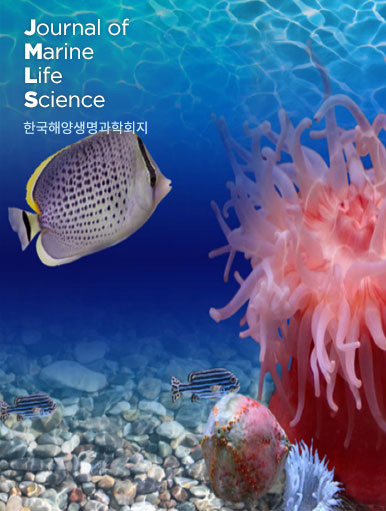![]() Journal Search Engine
Journal Search Engine
Download PDF
Export Citation
Metrics
Korean Bibliography
Effect of Water Temperature and Photoperiod on the Oxygen Consumption of Four Different Strains of Red Seabream, Pagrus major
Effect of Water Temperature and Photoperiod on the Oxygen Consumption of Four Different Strains of Red Seabream, Pagrus major
Abstract
We determined the effects of different water temperatures (15, 20, and 25℃) and photoperiod cycles (24L:0D, 12L:12D, and 0L:24D) on the oxygen consumption of the offspring of a cultured Japanese strain (JJ), a selected Korean strain (KK), and intraspecific hybrid strains (JK and KJ) of red seabream, Pagrus major, under starvation conditions. The different fish strains, water temperatures, and photoperiod cycles had effects on the mean oxygen consumption of fish. Oxygen consumption increased with increasing water temperatures for all photoperiod treatments (p <0.001). Fish held in continuous darkness (0L:24D) used consistently less oxygen than fish exposed to continuous light (p <0.05). The oxygen consumption of fish exposed to the light phase in a 12L:12D photoperiod was higher than that of fish in the dark phase of the 12L:12D cycle, and differences were significant in three of the strains: JJ (15℃), KK (15 and 20℃), and KJ (25℃). The oxygen consumption of the inbred (JJ and KK) and intraspecific hybrid (JK and KJ) strains varied with differing water temperatures and photoperiod cycles. The JK strain displayed significantly higher oxygen consumption than the other strains under all experimental conditions except 15℃ with a 0L:24D photoperiod. The JK and KJ strains usually showed the highest and lowest oxygen consumption values, respectively, whereas the inbred strains exhibited intermediate values. Oxygen consumption in the JJ and JK strains was usually higher than that of the KK and KJ strains. We propose that differences in the thermal sensitivity and photosensitization properties of the strains contribute to differences in their ability to adapt to changes in water temperature and photoperiod, thus resulting in differences in the amplitude of their metabolic rates.






